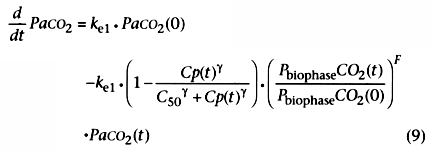Indirect Effect Models
Thus far we have been talking about effects that are an instantaneous
function of drug concentration at the site of drug effect, as implied by Equation
8. For example, once hypnotics reach the brain or muscle relaxants reach the muscles,
the effect is almost instantaneous. Some effects are much more complex. For example,
consider the effect of opioids on ventilation. Initially, opioids depress ventilation.
As a result of this ventilatory depression, CO2
accumulates. The accumulation
in CO2
acts to stimulate ventilation, thus partly offsetting the ventilatory
depressant effects of opioids. Ventilatory depression is an example in which a direct
and an indirect drug effect occurs. The direct effect of the opioid is to depress
ventilation, and the indirect effect is to increase CO2
. Modeling the
time course of opioid-induced ventilatory depression requires consideration of both
components. Bouillon and colleagues developed a model of ventilatory depression
that incorporates both direct and indirect effects.[32]
[33]
As is generally the case with indirect effect
TABLE 12-1 -- Time to peak effect and t½ ke0
after a bolus dose
|
Drug |
Time to Peak Drug Effect (min) |
t½ ke0
(min) |
|
Fentanyl |
3.6 |
4.7 |
|
Alfentanil |
1.4 |
0.9 |
|
Sufentanil |
5.6 |
3.0 |
|
Remifentanil |
1.6 |
1.3 |
|
Propofol |
2.2 |
2.4 |
|
Thiopental |
1.6 |
1.5 |
|
Midazolam |
2.8 |
4.0 |
|
Etomidate |
2.0 |
1.5 |
|
t½ ke0
, rate constant for transfer of drug
from the site of drug effect to the environment. |
models, characterizing drug-induced ventilatory depression requires considering the
entire time course of drug therapy, which is embodied in the following differential
equation:

where PaCO2
is the arterial CO2
,
Pbiophase
CO2
is the CO2
in the biophase (i.e., ventilation
control centers), ke1
is the rate constant
for CO2
elimination, C50
is the effect-site opioid concentration
associated with a 50% reduction in ventilatory drive, and F is the steepness or "gain"
of the CO2
effect on ventilatory drive.
